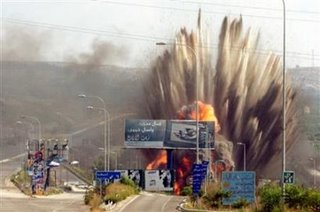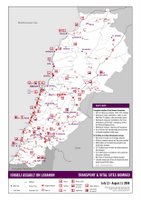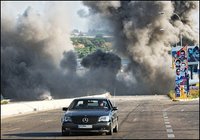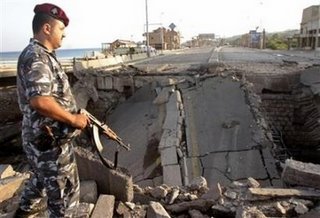 This assessment builds upon the Lebanon Damage Report 2006
This assessment builds upon the Lebanon Damage Report 2006 Updated August 20, 2006.
Roads vs Bridges:
The destruction of roads and bridges to cutoff tranportation routes is the primary focus of this report. In this sense, road and bridge bombings are similar, except that the difficulty and cost of re-building bridges is often much greater.Targeting Vehicles vs Targeting Roads:
Israel has targeted numerous vehicles on roads, which is different than targeting the road itself to cut off transportation routes. This report focuses on the later. A separate report is being developed on the topic of targetting civilian vehicles.
Israeli Rationale:
In the initial hours of Israel's assault on Lebanon, they claimed bridges were being destroyed to prevent Hezbullah from transporting the captured soldiers. Over time, this rational changed to preventing Hezbullah movement in general and to prevent the resupply of Hezbullah forces.However, Isreali statements, and the facts on the ground, indicate that Israel had deeper motives. For example, Israel said it held the Lebanese government responsible for the soldier's kidnapping. In this context, the damage inflicted on Lebanon's infrastructure seems intended to pressure the Lebanese government and pupulace to turn against Hezbullah. This psychological warefare strategy is well documented throught history, including US bombing of civilians in Germany and Japan during World War II. In the present case, Israel's strategy appears to have backfired, and leaves Israel vulnerable to legitimate charges of war crimes (collective punishment, disproportionate use of force, and failing to distinguish between military targets and civilian population.
Report Methodology:
Road and bridge bombings are very common. Repairs and re-bombings make it difficult to provide numbers of disabled roads. This damage report is not intended to be perfect, but rather attempts provide a reasonable, well-sourced estimate of the damage.

Summary of Damage to Roads and Bridges:
94 roads as of August 11 [1].
71 bridges have been destroyed [2][3][1][32]
72 overpasses have been destroyed [2]
Detailed Cases
Initial Week, July 12 - 18:
In the first week of the US-Israeli assault, 38 main roads were cut off, and 48 bridges were destroyed [4]July 13, In the initial assault, the Israeli military said it attacked 40 targets to stop Hezbollah from moving their two soldiers. One strike by Israeli jets hit a major junction along the main north-south coastal highway, wrecking the road and wounding two people. [5]
July 14, Israeli planes struck the main highway linking Beirut to the Syrian capital Damascus, a Lebanese security source said. The jets struck at least five separate times along different points of the international route.[6]
July 14, A woman was killed and six other civilians, including three paramedics, wounded in a strike on a bridge over the river Zahrani near the main coastal city of Sidon. [8]
July 15, Security officials said three other civilians were killed in an air raid on a bridge on the Beirut-Damascus highway. [7]
July 15, Israeli planes fired rockets near a Lebanese-Syrian border crossing, heightening fears it could extend its campaign to Syria. [9]
July 17, Nine civilians were killed, including two children, when an afternoon strike hit a bridge at the entrance to the southern port city of Sidon (Saida), Lebanese security officials said. [30] This is consistent with a reporst circulating the internet referencing an attack on the Rmayleih bridge, near Saida (Sidon) on July 15 or July 17 (might be an error in the label of a photo) killing 8 civilians. The reports are submitted by, "Hanady," who reference a Dr. Bashir Sham, member of "French Association of Cardiovascular Surgeons" at the "Southern Medical Center," who describes the unusual condition of the corpses. The conditions were characterized as follows: they were burnt , but their colour is dark , they're inflated, and they have a terrible smell" All this , and the hair is not burnt nor do the bodies bleed. (Similar reports in Doueir).
July 16, Another seven people were killed in other raids against bridges and petrol stations in eastern and southern Lebanon, including a strike that blocked the main border crossing into Syria [?]

Continued Attacks on Roads & Bridges:
July 19, Two civilians were killed and two wounded in air strikes on roads in Kfarshuba, Bazuriyeh and the nearby entrance of Tyre. [11]
July 20, The BBC reported, "Bombed roads are hampering aid efforts, with the UN warning the humanitarian crisis is worsening by the hour." The United Nations' emergency relief co-ordinator, Jan Egeland, said the wounded could not be helped because roads and bridges had been cut by Israeli air strikes. [10]
July 21 A section of Lebanon's oldest bridge, which is part of the Beirut-Damascus highway in central Lebanon, collapsed after being hit with four Israeli missiles. [12]
July 22, Israel said its aircraft had hit 150 targets inside Lebanon in the 24 hours to Saturday morning, including a dozen roads linking Lebanon to neighbouring Syria. [13]
July 24, UN relief chief Jan Egeland said, "Hundreds of bridges and virtually all road networks have been systematically destroyed leaving entire communities in the south inaccessible." [14]
July 29, Lebanon's main international border crossing was closed on Sunday, July 30, a day after Israeli warplanes struck the road leading to Syria. Heavy bombs had gouged out large craters on the road leading to the Syrian border at Masnaa in eastern Lebanon, witnesses said. The closure left one route through northern Lebanon to Syria as the only relatively safe passage out of the country. [15]
July 31, Israeli warplanes launched raids on eastern Lebanon on Monday, Lebanese security sources said, hours after Isreel claimed to suspended aerial bombardment of south Lebanon for 48 hours. The sources said at least two air strikes hit roads near the border with Syria in the early hours. [16]
August 2, Israeli aircraft wrecked at least three bridges in the northern tip of the Bekaa and in northern Lebanon. [17]
August 4, Israel again cut off all roads into Beirut including the north-south coastal highway. [18] Israeli air strikes destroyed four bridges north of Beirut on the main coastal highway. The bombing of bridges in the Christian heartlands north of Beirut cut off the main coastal highway to Syria. A bridge in the Maameltein area near Jounieh was destroyed. Five people, including a Lebanese army soldier, were killed and 12 wounded in the bombing of the bridges, the Red Cross said. [19][20]
Video Report LINK
Also of concern is the fact that the Qasmieh Bridge and the makeshift bridge between Saida and Tyre in the south were destroyed a few days ago, leading to the isolation of the city of Tyre. [21]
August 6, Israeli warplanes early Sunday carried out a series of air raids bombing two roads linking Lebanon's eastern Bekaa plain with Beirut and north Lebanon, as well as two bridges in Akkar province north of the capital, Lebanese police said. [22] In Beirut, on Sunday afternoon (Aug 6), warplanes dropped six bombs on the sector, destroying a 10-storey building and cutting the main road that crosses the suburb. [23]
August 7, Israeli warplanes early Monday carried out a dozen raids in east Lebanon, hitting roads linking the region with Syria, Lebanese police said without reporting any victims. Two raids targeted the road leading to the Masnaa border post, knocked out by previous attacks and hit again each time residents fill in the craters so as to be able to drive around, the police said. The fighter-bombers pounded the road between Baalbek and Rayak, linking the Baalbek region with Zahle in the centre of Lebanon, they said. Two other raids hit the Aita al-Fukhar road linking villages in the Bekaa Valley with Syria. [24]
August 10, Israel struck the border crossing at Masnaa in the Bekaa Valley. Masnaa is the main border crossing with Syria used by evacuating foreigners, and has been closed after four previous strikes. Israeli warplanes struck roads and villages in mountainous areas in the southeastern part of the Bekaa Valley. [25]
August 11, Isralie jets struck twice at a busy bridge at the Abboudiyeh border crossing into Syria, killing at least 12 people and wounding 18 others, hospital and security officials said. [26]
August 12, An Israeli air strike destroyed a road leading to the only remaining border crossing to Syria at Arida about a mile from the Mediterranean coast. It's the last official border post open for humanitarian convoys and civilians fleeing the country. A separate raid destroyed a bridge linking Tyre and Nabatiyeh with Sidon. [27][28]
August 13, Israeli fighter-bombers destroyed two bridges in the northern Akkar plains that link Tripoli with the Syrian border, wounding six people. The air strike on the bridge at Halba destroyed a large number of homes, causing civilian casualties, said a hospital worker. A number of Lebanese Army soldiers stationed nearby were also wounded in the attacks. The bridge in adjoining village was also destroyed. Eight other bridges in the area have already been destroyed. [29]
August 15, Tens of thousands of Lebanese jammed bomb-cratered roads Monday as they returned to still-smoldering scenes of destruction after a tenuous cease-fire ended 34 days of vicious combat between Israel and Hezbollah. [31]
August 19, Israel raid after the cease fire: The security officials said the commandos flew in by helicopter to a hill outside the village of Boudai west of Baalbek in eastern Lebanon, about 17 miles from the Syrian border. Witnesses said Israeli missiles destroyed a bridge during the fighting. [32]
Images:
LINK to IDF video of bridge being destroyed
Video Report of 4 Bridges destroyed August 4, 2006


Bridge at Damour

Bridge at Al Owali, Sidon (Saida)
Photos from Dar Jamail


SEE Dar Jamail's Photo Album for More
Sources:
[1] Lebanese Government via map made available from www.lebanonmaps.org.
[2] BBC, "Lebanon Damage Report"
Web Link
[3] Reuters, Lin Noueihed, August 4, 2006
Web LINK
[4] Wikipedia referencing the Financial Times, July 19, 2006.
Web LINK
[5] The Sun UK
Web LINK
[6] YnetNews, July 14, 2006
Web LINK
[7] Naharnet News Desk, July 15, 2006.
Web LINK
[8] Beirut, July 14, 2006 AFP
Web LINK
[9] Reuters, July 15, 2006
Web LINK
[10] BBC, July 20, 2006
Web LINK
[11] Beirut, July 19, 2006 AFP
Web LINK
[12] Canadian Broadcast Corporation, July 21, 2006
Web LINK
[13] AFP, Beirut, July 22, 2006
Web LINK
[14] AFP, Beirut, July 24, 2006
Web LINK
[15] AFP, MASNAA, Lebanon, July 30, 2006
Web LINK
[16] Reuters, Beirut, July 31, 2006
Web LINK
[17] Reuters, August 2, 2006
Web LINK
[18] CNN, August 4, 2006
Web LINK
[19] Reuters, August 4, 2006
Web LINK
[20] Reuters, Lin Noueihed, August 4, 2006
Web LINK
[21] Action by Churches Together (ACT) - Switzerland
Elisabeth Gouel, August 6, 2006.
Web LINK
[22] Beirut, Lebanon Aug 7, (AFP)
Web LINK
[23] BAALBEK, Lebanon, Aug 6 (AFP)
Web LINK
[24] BAALBEK, Lebanon, Aug 7 (AFP)
Web LINK
[25] Associated Press, CHRISTOPHER TORCHIA, August 11, 2006
Web LINK
[26] August 11, 2006 (AFP)
Web LINK
[27] Beirut, Aug 12, 2006 (AFP)
Web LINK
[28] Associated Press, ZEINA KARAM, August 12, 2006.
Web LINK
[29] SIDON, Lebanon, Aug 13 (AFP)
Web LINK
[30] Associated Press, Ravi Nessman July 17, 2006.
Web LINK
[31] Associated Press, Steven R. Hurst, AP August 15, 2006
Web LINK
[32] Associated Press, SAM F. GHATTAS, August 20, 2006.
Web LINK



2 comments:
This blog is amazing!!!I love to drive by a bridge, actually there are bridge beautiful for their structure or their size. simply love it. I´ll approach
costa rica investment opportunities in this country there are land that need big bridges.
Thanks for the article, very effective information.
Post a Comment